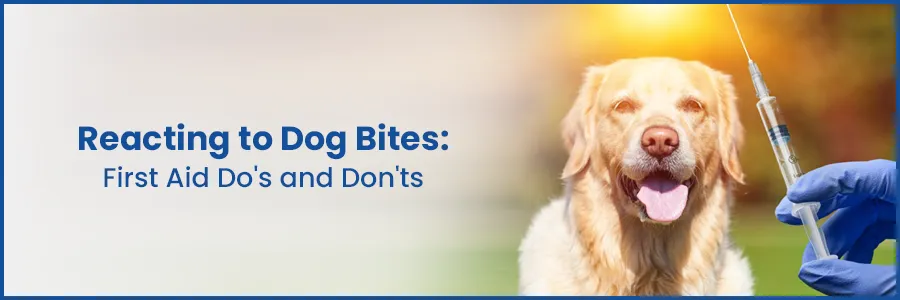
Reacting to Dog Bites: First Aid Do's and Don'ts
Interactions with dogs can bring immense joy, but occasionally, an unexpected dog bite can occur. In such situations, knowing how to respond promptly and effectively can make a significant difference in preventing complications. This blog delves into the essential first aid do's and don'ts to consider when reacting to dog bites. Whether you're a dog owner or simply someone who loves being around dogs, understanding these guidelines can prove invaluable.
Understanding Dog Bites and Their Symptoms
Dog bites can range from minor to severe, and it's crucial to recognize the symptoms. Common signs include puncture wounds, broken skin, bleeding, pain, and swelling around the affected area. In some cases, infection risk is a concern due to bacteria in the dog's mouth.
First Aid Do's for Dog Bites
- Clean the Wound : Rinse the wound gently with clean water and mild soap for several minutes. Cleaning helps reduce the risk of infection.
- Apply Pressure : If the wound is bleeding, apply gentle pressure using a clean cloth to help control bleeding.
- Elevate if Needed : If the bite is on a limb, elevate it to help reduce swelling.
- Use Antibiotic Ointment : Apply an antibiotic ointment and cover the wound with a clean OR sterile bandage to prevent infection.
- Seek Medical Attention : Even if the bite seems minor, it's advisable to consult a healthcare professional to assess the risk of infection, especially if it's a deep or puncture wound.
Secure your health with a second opinion. Make informed decisions and book your appointment today!
Get A Second OpinionFirst Aid Don'ts for Dog Bites
- Don't Ignore the Bite : Even if it seems minor, don't dismiss a dog bite. Infections can develop, and complications can arise if left untreated.
- Don't Agitate the Dog : After a bite, avoid provoking the dog further. Give it space to calm down and reduce the risk of further bites.
- Don't Delay Medical Attention : If the wound is deep, bleeding heavily, or shows signs of infection like skin redness and warmth, seek medical care promptly.
- Don't Use Harsh Chemicals : Avoid using harsh disinfectants or hydrogen peroxide on the wound, as these can damage the tissues and delay healing.
- Don't Ignore Tetanus Shots : If your last tetanus shot was more than five years ago, consider getting a booster shot.
Treatment and Prevention
While first aid is crucial, seeking professional medical care is essential, especially for deeper wounds or if the dog is unknown or potentially carrying rabies. Health professionals can determine whether rabies vaccination or other treatments are necessary.
Expertise of Our Specialists at Medicover:
Medicover prides itself on having a team of highly trained medical professionals who specialize in emergency and trauma care and also Our Rabies specialists have a deep understanding of wound management, infection prevention, and the unique challenges that come with treating dog bite injuries. Our medical team includes:
Conclusion:
Reacting to dog bites with the right first aid measures can significantly reduce the risk of complications and infections. Remember, prevention is key: always approach dogs calmly, ask the owner for permission before petting, and respect the dog's boundaries. By understanding the do's and don'ts of first aid for dog bites, you can ensure the safety and well-being of both yourself and the furry friends you encounter.
Secure your health with a second opinion. Make informed decisions and book your appointment today!
Book an AppointmentFrequently Asked Questions
Wash the wound softly with soap and warm water for about five minutes. This helps reduce the risk of infection.
Yes, apply gentle pressure using a clean cloth or bandage to control the bleeding. Elevating the wound can also help.
Yes, it's recommended to see a doctor for any dog bite, as even seemingly minor bites can lead to infections. A medical professional can assess the wound and determine if additional treatment is needed.
Look out for increased redness, swelling, warmth, or pus around the wound. If you experience fever, chills, or any worsening symptoms, seek medical attention.
No, avoid using hydrogen peroxide or alcohol as they can damage tissue. Stick to washing the wound with soap and water.
It's best to consult a doctor before applying any creams. They will advise on appropriate treatments based on the severity of the bite.
Yes, reporting the incident is important for public safety. It helps authorities monitor potentially dangerous dogs and prevent future incidents.
Keep the wound clean and covered, watch for signs of infection, and follow your doctor's recommendations for antibiotics if prescribed.
Though rare, rabies can be transmitted through bites. If the dog's rabies vaccination status is unknown, consult a healthcare provider to determine if rabies prophylaxis is necessary.
If the bite is deep, large, or located on the face, hands, or feet, seek medical help for proper wound closure. For minor bites, clean the wound and apply a sterile bandage.
If your tetanus vaccination is not up to date, a dog bite could warrant a tetanus shot. Consult a healthcare provider for guidance based on your vaccination history.
Yes, taking photos of the wound can be helpful for documentation purposes, especially if legal or medical issues arise later.
Yes, you can apply a cold compress wrapped in a cloth to the wound for short periods to reduce swelling.
If the dog is unfamiliar to you or its behavior is concerning, avoid trying to restrain it. Contact animal control or local authorities to report the incident.
Yes, ensure you complete any prescribed antibiotics, attend follow-up appointments, and continue to monitor the wound for signs of infection.
